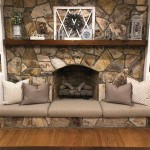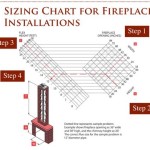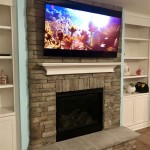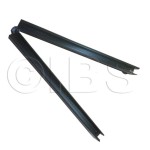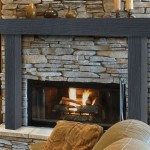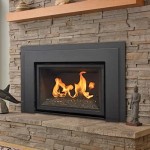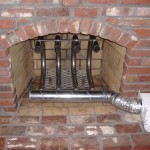Wall Mount Gas Fireplaces: A Comprehensive Guide
Wall mount gas fireplaces offer a contemporary and space-saving heating solution for homes. They provide the ambiance of a traditional fireplace without the need for a large hearth or chimney. These units are designed to be directly affixed to a wall, making them ideal for apartments, condominiums, or any space where floor space is limited. Their installation and operation necessitate a thorough understanding of their features, benefits, and safety considerations.
A wall mount gas fireplace operates by burning natural gas or propane to generate heat and produce realistic-looking flames. The gas is fed into a burner, where it mixes with air and is ignited. The resulting flame heats a set of ceramic logs, glass beads, or other decorative media, which radiate heat into the room. Modern wall mount gas fireplaces incorporate advanced safety features, such as oxygen depletion sensors (ODS) and automatic shut-off systems, to ensure safe and reliable operation.
The popularity of wall mount gas fireplaces stems from their aesthetic appeal, ease of installation, and efficient heating capabilities. They are available in a wide range of styles and sizes, allowing homeowners to choose a model that complements their existing décor. Furthermore, many units can be controlled remotely, providing convenience and flexibility in managing the heat output and flame intensity.
Understanding the Advantages of Wall Mount Gas Fireplaces
One of the primary advantages of wall mount gas fireplaces is their space-saving design. Unlike traditional fireplaces that require significant floor space for the hearth and chimney, wall mount units are directly attached to the wall, freeing up valuable floor area. This makes them particularly suitable for smaller rooms or apartments where space is at a premium.
Installation is generally simpler and less costly compared to traditional fireplaces. Since wall mount units do not require a chimney, the installation process is streamlined. However, professional installation is still recommended to ensure proper gas line connections and venting, if required. Venting options typically include direct vent, vent-free, and power vent models, each with its own set of installation requirements and considerations.
Wall mount gas fireplaces offer efficient heating capabilities. They provide supplemental heat that can help reduce reliance on central heating systems, potentially lowering energy bills. The heat output can be adjusted to suit individual preferences and room size, providing a comfortable and energy-efficient heating solution. The ability to control the flame intensity and heat output remotely adds to the convenience and energy savings.
The aesthetic appeal of wall mount gas fireplaces is another significant draw. They are available in a variety of styles, from sleek and modern designs to more traditional looks. Features such as realistic-looking flames and decorative media enhance the ambiance of any room. Many units offer customizable options, such as adjustable flame height, variable flame colors, and different media types, allowing homeowners to create a fireplace that perfectly matches their personal style.
Key Considerations Before Purchasing a Wall Mount Gas Fireplace
Before purchasing a wall mount gas fireplace, it is crucial to assess the space where it will be installed. Measure the available wall space to ensure that the unit will fit comfortably. Consider the overall décor of the room and choose a fireplace style that complements the existing furniture and design elements. Also, evaluate the structural integrity of the wall where the fireplace will be mounted to ensure it can support the weight of the unit.
Venting requirements are a critical consideration. Wall mount gas fireplaces are available in three main venting options: direct vent, vent-free, and power vent. Direct vent fireplaces draw combustion air from outside and vent exhaust gases directly outside through a sealed system. Vent-free fireplaces burn gas more efficiently and do not require venting, but they must be used in well-ventilated rooms and may not be permitted in all jurisdictions. Power vent fireplaces use a fan to exhaust gases through a vent pipe, allowing for more flexible installation options. Understanding the venting requirements and local building codes is essential to ensure safe and compliant installation.
Gas line connections are another important aspect. A qualified gas technician should install the gas line to the fireplace. Ensure that the gas line is properly sized and that all connections are leak-tested before operating the fireplace. If natural gas is not available, propane can be used as an alternative, but this requires a propane tank and regulator.
Safety features are paramount. Look for wall mount gas fireplaces that incorporate safety devices such as oxygen depletion sensors (ODS) and automatic shut-off systems. The ODS monitors the oxygen level in the room and shuts off the gas supply if the oxygen level drops too low, preventing carbon monoxide poisoning. Automatic shut-off systems will turn off the fireplace if it overheats or if the pilot light goes out.
Budget considerations also play a role in the selection process. Wall mount gas fireplaces range in price depending on size, features, and brand. Factor in the cost of installation, including gas line connections and venting, when calculating the total cost. Research different models and compare prices from various retailers to find the best value.
Installation and Maintenance of Wall Mount Gas Fireplaces
Professional installation is highly recommended for wall mount gas fireplaces. A qualified gas technician can ensure that the gas line is properly connected and that the venting system is installed correctly. This will minimize the risk of gas leaks, carbon monoxide poisoning, and other safety hazards. Furthermore, professional installation can help ensure that the fireplace operates efficiently and complies with local building codes.
Proper ventilation is crucial for safe and efficient operation. Follow the manufacturer's instructions for venting requirements. Ensure that the vent pipes are properly sealed and that there are no obstructions in the vent path. Regularly inspect the vent system for any signs of damage or corrosion. If you have a vent-free fireplace, ensure that the room is well-ventilated and that the fireplace is not used for extended periods in enclosed spaces.
Regular cleaning and maintenance are essential for keeping your wall mount gas fireplace operating smoothly. Clean the glass front of the fireplace with a non-abrasive cleaner to remove soot and debris. Inspect the burner and gas orifices for any clogs or obstructions. Clean the decorative media, such as ceramic logs or glass beads, to maintain their appearance. Schedule an annual inspection by a qualified gas technician to ensure that all components are functioning properly and that there are no potential safety hazards.
During the inspection, the technician will check the gas pressure, burner performance, venting system, and safety features. They will also clean the burner and pilot light and inspect the gas line connections for leaks. Regular maintenance can help extend the lifespan of your wall mount gas fireplace and ensure that it operates safely and efficiently for years to come.
When cleaning the fireplace, always turn off the gas supply and allow the unit to cool completely before proceeding. Use a soft brush or vacuum cleaner to remove dust and debris from the interior of the fireplace. Avoid using harsh chemicals or abrasive cleaners, as these can damage the components. Refer to the manufacturer's instructions for specific cleaning recommendations.
It is essential to be aware of potential safety hazards associated with gas fireplaces. Never leave a gas fireplace unattended while it is operating. Keep flammable materials, such as curtains, furniture, and paper, away from the fireplace. Install carbon monoxide detectors in your home and check them regularly to ensure they are functioning properly. If you smell gas or suspect a gas leak, immediately turn off the gas supply and contact a qualified gas technician.
In conclusion, wall mount gas fireplaces provide an elegant and space-saving heating solution for modern homes. Their ease of installation, efficient heating capabilities, and aesthetic appeal make them a popular choice among homeowners. By understanding the advantages, considerations, and maintenance requirements of wall mount gas fireplaces, homeowners can make informed decisions and enjoy the warmth and ambiance of a fireplace without the drawbacks of traditional models.

Fire Ribbon Direct Vent Slim Gas Fireplace Spark Modern Fires

Vent Free Archives SÓlas Contemporary Fireplaces

Loft Wall Mounted Gas Stoves Gazco

Plazmafire Vf24 Whvf24 Ambassador Fireplaces

Wall And Floor Mount Gas Or Bio Fuel Fireplaces Syam Distributors

Gas Heating Stove Standalone 75 Ortal Usa Wall Mounted Contemporary Metal

Spark Fireplaces Fire Ribbon 46bk 46 X 12 Black Finish Surround Direct Vent Slim Propane Gas Fireplace With Sa Wall Mounted

Napoleon Gas Direct Vent Wall Mount Fireplace Whd48 Fireplaces Hvacdirect Com

Our Guide To Wall Mounted Fires Installation Direct Fireplaces

Napoleon Plazmafire 31 Direct Vent Gas Fireplace Toronto Best
Related Posts

